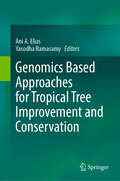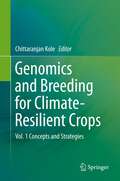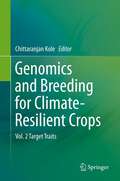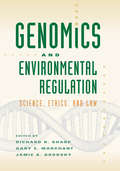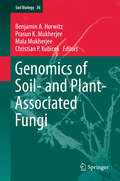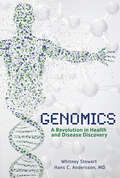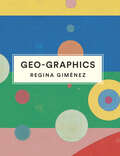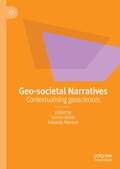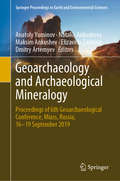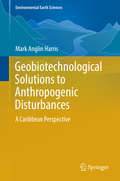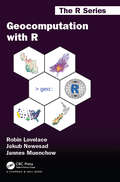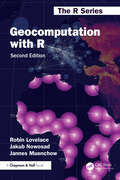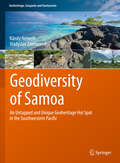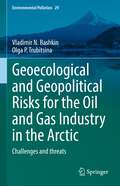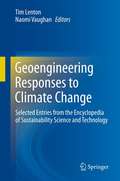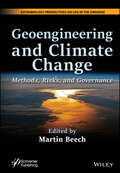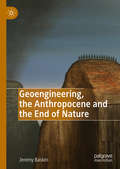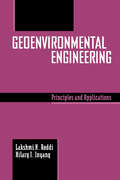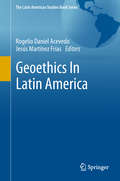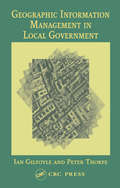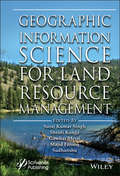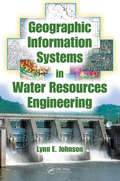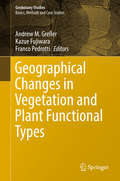- Table View
- List View
Genomics Based Approaches for Tropical Tree Improvement and Conservation
by Yasodha Ramasamy Ani A. EliasThis book offers foundational knowledge to advance genomic approaches in forest tree improvement and genetic resource conservation. The tropical tree breeding sector has fallen behind in genomic breeding not due to a lack of resources but rather a limited understanding and an underdeveloped genomic breeding pipeline. While marker-assisted selection (MAS) has been the preferred method for incorporating genomic data into breeding programs, it primarily targets major genes, overlooking minor gene effects. This limitation makes MAS less effective for enhancing quantitative traits such as heartwood content. The primary goal of statistical methodologies using whole-genome information is to predict promising candidates for breeding advancement/commercialization while efficiently managing resources such as land, labor, and, most critically, time. Given the long rotation period of forest tree crops, the ability to identify, select, and modify genotypes with high heritability for economically valuable traits within a shorter timeframe marks a significant advancement in breeding. This book provides comprehensive guidelines on leveraging genomic data, including pathogenomics, to breed resilient, future-ready trees and manage populations effectively. To reinforce these guidelines, the book presents case studies on species such as Tectona grandis, Santalum album, Casuarina, Shorea, Artocarpus, tropical and sub-tropical pines, and tropical fruit trees. Additionally, the book explores broader applications of genetic data, including timber tracing and the conservation of germplasm while minimizing genetic redundancy. This book will be a valuable resource for tropical tree breeders and researchers, equipping them with the methods and tools needed to adopt advanced genomic breeding. Additionally, students and scholars will benefit from the comprehensive information it provides, enhancing their understanding of modern breeding techniques.
Genomics and Breeding for Climate-Resilient Crops
by Chittaranjan KoleClimate change is expected to have a drastic impact on agronomic conditions including temperature, precipitation, soil nutrients, and the incidence of disease pests, to name a few. To face this looming threat, significant progress in developing new breeding strategies has been made over the last few decades. The first volume of Genomics and Breeding for Climate-Resilient Crops presents the basic concepts and strategies for developing climate-resilient crop varieties. Topics covered include: conservation, evaluation and utilization of biodiversity; identification of traits, genes and crops of the future; genomic and molecular tools; genetic engineering; participatory and evolutionary breeding; bioinformatics tools to support breeding; funding and networking support; and intellectual property, regulatory issues, social and political dimensions.
Genomics and Breeding for Climate-Resilient Crops: Vol. 2 Target Traits
by Chittaranjan KoleClimate change is expected to have a drastic impact on agronomic conditions including temperature, precipitation, soil nutrients, and the incidence of disease pests, to name a few. To face this looming threat, significant progress in developing new breeding strategies has been made over the last few decades. The second volume of Genomics and Breeding for Climate-Resilient Crops describes various genomic and breeding approaches for the genetic improvement of the major target traits. Topics covered include: flowering time; root traits; cold, heat and drought tolerance; water use efficiency; flooding and submergence tolerance; disease and insect resistance; nutrient use efficiency; nitrogen fixation; carbon sequestration; and greenhouse gas emissions.
Genomics and Environmental Regulation: Science, Ethics, and Law
by Gary E. Marchant Richard R. Sharp Jamie A. GrodskyTo reduce the deleterious effects of environmental contamination, governments across the world have enacted regulations broadly conceived for entire populations. Information arising out of the Human Genome Project and other cutting-edge genetic research is shifting the policymaking process. This fascinating volume draws on experts from academia, government, industry, and nongovernmental organizations to examine the science of genomic research as applied to environmental policy. The first section explores environmental policy applications, including subpopulation genetic profiling, industrial regulations, and standardizing governmental evaluation of genomic data. The second section assesses from multiple angles the legal framework involved in applying genomics to environmental regulation. In the third section, the contributors review closely the implications of genomic research for occupational health, from disease prevention and genetic susceptibility to toxicants, to workers’ rights and potential employment discrimination. A fourth section explores the bioethical and philosophical complications of bringing genetic data and research into nonclinical regulatory frameworks.Genomics and Environmental Regulation points to ways in which information on toxicology and genetics can be used to craft more precise and efficient regulations.
Genomics of Soil- and Plant-Associated Fungi
by Christian P. Kubicek Mala Mukherjee Prasun K. Mukherjee Benjamin A. HorwitzThis volume addresses the similarities and also the differences in the genomes of soil saprophytes, symbionts, and plant pathogens by using examples of fungal species to illustrate particular principles. It analyzes how the specific interactions with the hosts and the influence of the environment may have shaped genome evolution. The relevance of fungal genetic research and biotechnological applications is shown for areas such as plant pathogenesis, biomass degradation, litter decomposition, nitrogen assimilation, antibiotic production, mycoparasitism, energy, ecology, and also for soil fungi turning to human pathogens. In addition to the model organisms Neurospora and Aspergillus, the following species are covered providing a view of pathogens and mutualists: Trichoderma, Fusarium oxysporum, Cochliobolus heterostrophus, Penicillium chrysogenum, Rhizopus oryzae, Podospora anserina, Agaricomycetes, Archaeorhizomycetes and Magnaporthaceae. Ecology and potential applications have guided the choice of fungal genes to be studied and it will be fascinating to follow the trends of future sequencing projects.
Genomics: A Revolution in Health and Disease Discovery
by Whitney Stewart Hans C. AnderssonOver the past 50 years, scientists have made incredible progress in the application of genetic research to human health care and disease treatment. Innovative tools and techniques, including gene therapy and CRISPR-Cas9 editing, can treat inherited disorders that were previously untreatable, or prevent them from happening in the first place. You can take a DNA test to learn where your ancestors are from. Police officers can use genetic evidence to identify criminals—or innocents. And some doctors are using new medical techniques for unprecedented procedures. Genomics: A Revolution in Health and Disease Discovery delves into the history, science, and ethics behind recent breakthroughs in genetic research. Authors Whitney Stewart and Hans Andersson, MD, present fascinating case studies that show how real people have benefitted from genetic research. Though the genome remains full of mysteries, researchers and doctors are working hard to uncover its secrets and find the best ways to treat patients and cure diseases. The discoveries to come will inform how we target disease treatment, how we understand our health, and how we define our very identities.
Gentian Hill
by Elizabeth GoudgeUnable to bear the prospect of a life at sea, young Anthony O'Connell deserts his ship at Torquay and escapes into the Devonshire countryside under a new name. When Stella Sprigg, adopted daughter of a local farmer, encounters 'Zachary', the pair instantly know they are destined to be together. Intertwined with the local legend of St. Michael's Chapel, Stella and Zachary's story takes them from the secluded Devonshire valley to the perilous Mediterranean seas and finally to the poverty and squalor of eighteenth-century London.
Gentleman Captain (The Matthew Quinton Journals)
by J. D. Davies&“A promising 17th-century English nautical saga&” featuring a new captain whose command of a Royal Navy warship makes him &“a hero worth rooting for&” (Publishers Weekly). 1662: After Matthew Quinton sunk the first ship he was given to command, he is surprised when the King gives him captaincy of H.M.S. Jupiter with orders to stamp out a Scottish rebellion. This time Quinton is determined to prove his worth. In a country of divided loyalties, Charles II needs someone he can trust, and—with an elder brother deep in the King&’s confidence—Matthew is one of the few eligible candidates. But now Quinton must face an unruly crew, suspicions of murder, stirrings of conspiracy and the angry seas. Will treason be found in Scotland . . . or is it lurking closer to home? Packed with gripping sea adventures, Gentleman Captain is the first in the epic Matthew Quinton Journals, a series of extraordinary nautical sagas. Praise for the writing of J. D. Davies: &“Hornblower, Aubrey and Quinton--a pantheon of the best adventures at sea!&” —Conn Iggulden, #1 New York Times–bestselling author of The Conqueror and War of the Roses series &“Swashbuckling suspense, royal intrigue, and high seas naval action . . . An excellent series.&” —Publishers Weekly &“Utterly impossible to put down . . . Finely-shaded characters, excellent plotting, gut-clenching action and immaculate attention to period detail . . . superb.&” —Angus Donald, author of The Outlaw Chronicles series &“Destined to be a classic of nautical adventure series.&” —Eric Jay Dolin, author of Leviathan and Fur, Fortune, and Empire &“A naval adventure that goes well beyond the usual outlines of the genre to paint a lively portrait of England in the 1600s.&” —Kirkus Reviews
Geo-Graphics
by Regina GiménezOur universe is brimming with secrets, and surprising curiosities. Here readers will learn the answers to all the questions they've asked themselves:What does the Sun look like from different planets in our galaxy? Why doesn't the Moon always appear the same? What is the largest river on Earth? And the highest mountain?In Geo-Graphics, our world becomes transformed by acclaimed artist Regina Giménez, into 96 pages of gorgeous shapes and colors. Planets and stars, continents and islands, rivers and lakes, volcanos and hurricanes … here they are presented as circles, polygons, lines, spirals, and accompanying facts that explain the world around us.This special and unusual atlas is a marriage of science and art like no other.
Geo-societal Narratives: Contextualising geosciences
by Martin Bohle Eduardo MaroneThis book provides an accessible overview of the societal relevance of contemporary geosciences. Engaging various disciplines from humanities and social sciences, the book offers philosophical, cultural, economic, and geoscientific insights into how to contextualise geosciences in the node of Culture and Nature.The authors introduce two perspectives of societal geosciences, both informed by the lens of geoethics. Throughout the text core themes are explored; human agency, the integrity of place, geo-centricity, economy and climate justice, subjective sense-making and spirituality, nationalism, participatory empowerment and leadership in times of anthropogenic global change. The book concludes with a discussion on culture, education, or philosophy of science as aggregating concepts of seemingly disjunct narratives.The diverse intellectual homes of the authors offer a rich resource in terms of how they perceive human agency within the Earth system. Two geoscientific perspectives and fourteen narratives from various cultural, social and political viewpoints contextualise geosciences in the World(s) of the Anthropocene.
Geoarchaeology and Archaeological Mineralogy: Proceedings of 6th Geoarchaeological Conference, Miass, Russia, 16-19 September 2019 (Springer Proceedings In Earth And Environmental Sciences)
by Anatoly Yuminov Natalia Ankusheva Maksim Ankushev Elizaveta Zaykova Dmitry ArtemyevThis book presents general problems in geoarchaeology, and discusses geophysical solutions, X-ray fluorescence spectrometry applications, X-ray and isotope analyses and GIS technologies. It also examines practical reconstructions of technological processes used in ancient time, and investigates the use of minerals and rocks by ancient societies in the territories of modern Russia, Ukraine, Turkmenistan, and Tajikistan, as well as the characteristics of ores, metallurgical slags and data on the composition and impurities of archaeological metals. Intended for archaeologists, historians, museum workers and geologists studying noble metals and copper, the book is also a useful resource for students, graduate students, experts and anyone interested in the use of various minerals at different stages of humanity’s development.
Geobiotechnological Solutions to Anthropogenic Disturbances
by Mark Anglin HarrisThis book offers a problem-and-solution approach toenvironmental remediation in mining, including the environmentally sustainableutilization of waste materials from the mining industry. It largely comprisesarticles published in Springer journals, which have been thoroughly revised andexpanded. With supplementary data and illustrations, it discusses specificproblem areas in relevant Caribbean locations and provides an overview ofgeotechnical and microbial solutions to prevent post-mining deterioration inthis area.
Geocomputation with R (Chapman & Hall/CRC The R Series)
by Robin Lovelace Jakub Nowosad Jannes MuenchowGeocomputation with R is for people who want to analyze, visualize and model geographic data with open source software. It is based on R, a statistical programming language that has powerful data processing, visualization, and geospatial capabilities. The book equips you with the knowledge and skills to tackle a wide range of issues manifested in geographic data, including those with scientific, societal, and environmental implications. This book will interest people from many backgrounds, especially Geographic Information Systems (GIS) users interested in applying their domain-specific knowledge in a powerful open source language for data science, and R users interested in extending their skills to handle spatial data. The book is divided into three parts: (I) Foundations, aimed at getting you up-to-speed with geographic data in R, (II) extensions, which covers advanced techniques, and (III) applications to real-world problems. The chapters cover progressively more advanced topics, with early chapters providing strong foundations on which the later chapters build. Part I describes the nature of spatial datasets in R and methods for manipulating them. It also covers geographic data import/export and transforming coordinate reference systems. Part II represents methods that build on these foundations. It covers advanced map making (including web mapping), "bridges" to GIS, sharing reproducible code, and how to do cross-validation in the presence of spatial autocorrelation. Part III applies the knowledge gained to tackle real-world problems, including representing and modeling transport systems, finding optimal locations for stores or services, and ecological modeling. Exercises at the end of each chapter give you the skills needed to tackle a range of geospatial problems. Solutions for each chapter and supplementary materials providing extended examples are available at https://geocompr.github.io/geocompkg/articles/.
Geocomputation with R (Chapman & Hall/CRC The R Series)
by Robin Lovelace Jakub Nowosad Jannes MuenchowGeocomputation with R is for people who want to analyze, visualize, and model geographic data with open source software. The book provides a foundation for learning how to solve a wide range of geographic data analysis problems in a reproducible, and therefore scientifically sound and scalable way. The second edition features numerous updates, including the adoption of the high-performance terra package for all raster data processing, detailed coverage of the spherical geometry engine s2, updated information on coordinate reference systems and new content on openEO, STAC, COG, and gdalcubes. The data visualization chapter has been revamped around version 4 of the tmap package, providing a fresh perspective on creating publication-quality maps from the command line. The importance of the book is also highlighted in a new foreword by Edzer Pebesma.The book equips you with the knowledge and skills necessary to tackle a wide range of issues manifested in geographic data, including those with scientific, societal, and environmental implications. The book is especially well-suited to: Data scientists and engineers interested in upskilling to handle spatial data. People with existing geographic data skills interested in developing powerful geosolutions via code. Anyone who needs to work with spatial data in a reproducible and scalable way. The book is divided into three parts: Foundations, Extensions, and Applications, covering progressively more advanced topics. The exercises at the end of each chapter provide the necessary skills to address various geospatial problems, with solutions and supplementary materials available at r.geocompx.org/solutions/.
Geodiversity of Samoa: An Untapped and Unique Geoheritage Hot Spot in the Southwestern Pacific (Geoheritage, Geoparks and Geotourism)
by Károly Németh Vladyslav ZakharovskyiThis book represents a pioneering effort, offering a comprehensive summary of the Geoheritage of the Southwestern Pacific (SW Pacific). Despite its globally significant Geoheritage , the region has not yet been addressed in its entirety within a cohesive geocultural context, either in book form or through similar media. The SW Pacific is still emerging as a focal point of Geoheritage research, and exploration of the vast geodiversity of this region has only recently begun. While some initial scientific reports exist for specific areas within the SW Pacific, there has been no comprehensive summary covering the entire region. Although the region is primarily renowned for its picturesque beaches and tranquil coastal landscapes, its rich Geocultural aspects remain largely underutilized and understudied. It aims to fill this gap by providing a holistic exploration of the geodiversity and geoheritage of the Samoa islands. By offering an evidence-based and scientifically valid overview of the islands' geoheritage and geodiversity, the book seeks to serve as a foundational resource for future developments in the tourism sector and to define research directions and methodologies for expanding our understanding of volcanic oceanic islands' geoheritage. It will focus on geodiversity and geoheritage within the context of volcanic oceanic islands, which are unique in terms of their geological formations (such as volcanoes and lava fields) and their limited spatial extent within the vast Pacific Ocean basin. This book will also highlight the special coastal regions of volcanic oceanic islands, which often feature fringed reefs and broad shallow marine environments housing unique and fragile ecosystems sensitive to global and planetary changes. By estimating geodiversity, the book will provide insight into how volcanic islands' geoheritage intersects with biodiversity. Geodiversity will be explored as the backdrop for the evolution of tropical marine and mountainous biodiversity in spatially limited areas under tropical conditions. Moreover, this book aims to be a pioneering contribution, offering a methodological manual for exploring other islands from a geodiversity perspective. Currently, there is no similar publication on the market, making this book one of the first of its kind. The authors have conducted extensive research in Samoa, resulting in numerous high-level scientific publications and a wealth of information to be included in this book.
Geoecological and Geopolitical Risks for the Oil and Gas Industry in the Arctic: Challenges and threats (Environmental Pollution #29)
by Vladimir N. Bashkin Olga Р. TrubitsinaThis book discusses issues of geoecological (GER) and geopolitical (GPR) risks due to hydrocarbon development of the Arctic. The authors explain the ethical and philosophical foundations of understanding environmental equity and justice in relation to the development of Arctic natural resources and consider various approaches to the moral aspects of making global management decisions in the field of environmental protection and environmental safety. Special attention is paid to analysis of modern geopolitical and geostrategic challenges to the development of the Arctic region. The monograph identifies the key geopolitical factors affecting the sustainable development of the Arctic and analyzes the similarities and differences in the geostrategic positions of the five Arctic states. The authors reveal the need to consider geopolitical challenges in the process of GER analysis for oil and gas development in the Arctic region. The book explores the intersection of the strategic interests for a number of states and describes Russia's inability to ensure environmental safety in the development of Arctic deposits. The book analyzes in detail each type of GER with an emphasis on their potential to lead to additional opportunities and threats, and assesses environmental rating as an indicator of the GER management process of Russian oil and gas companies operating in the Arctic. Although the main focus is on the Russian part of this region, many arguments and conclusions are quite applicable to the entire Arctic region. The consideration of geoecological and geopolitical aspects of the development of Arctic resources with the example of Russian oil and gas companies sheds light on the entire Arctic region, taking into account the interests of all other national and international companies involved in GER and GPR there.
Geoengineering Responses to Climate Change
by Naomi Vaughan Tim LentonFailure by the international community to make substantive progress in reducing CO2 emissions, coupled with recent evidence of accelerating climate change, has brought increasing urgency to the search for additional remediation approaches. This book presents a selection of state-of-the-art geoengineering methods for deliberately reducing the effects of anthropogenic climate change, either by actively removing greenhouse gases from the atmosphere or by decreasing the amount of sunlight absorbed at the Earth's surface. These methods contrast with more conventional mitigation approaches which focus on reducing emissions of greenhouse gases, especially carbon dioxide. Geoengineering technologies could become a key tool to be used in conjunction with emissions reduction to limit the magnitude of climate change. Featuring authoritative, peer-reviewed entries from the Encyclopedia of Sustainability Science and Technology, this book presents a wide range of climate change remediation technologies.
Geoengineering and Climate Change: Methods, Risks, and Governance (Astrobiology Perspectives on Life in the Universe)
by Martin BeechThis important and timely book assembles expert scientists from both sides of the debate to discuss Earth-based and space-based climate intervention technologies including the scale, deployment, risk management, and moral philosophy behind these technologies. The role that geoengineering might play, within the context of global warming amelioration, has long been contentious. For all this, geoengineering is about getting down and dirty with respect to the issue of climate intervention. Often dismissed as an option of last resort, geoengineering is now emerging as a key component in humanity’s drive to bring the impacts of global warming under some form of mitigation and control. While geoengineering does not solve the fundamental problem of continued anthropomorphic carbon dioxide emissions, the root cause of global warming, it is an option that can effectively buy humanity some much-needed time. Time, that is, to act positively, and time to introduce meaningful emission reductions, and deploy large-scale sequestration technologies. Indeed, the failure to meaningfully corral greenhouse gas emission levels, and the slow development of large-scale carbon capture technologies, will, by the close of the 21st century, likely see global temperatures increase by at least 2 or 3 degrees above pre-industrial levels. What geoengineering can potentially do for us is to offset the more extreme climate change scenarios that are presently projected to come about. An integrated geoengineering program to cool Earth’s atmosphere, running in parallel with the development of sequestration technologies, and substantial emission reductions, can work to limit the worst effects of climate change that will, without geoengineering, surely come about. Geoengineering is not a neutral or benign action, however, and if it is to be deployed, then much more research, and field testing of ideas and technologies is urgently needed. The authors in this book present a cross-section of philosophies, engineering approaches, and reactions to the idea of geoengineering. Through their words, the reader is introduced to the historical and contemporary debate concerning the potential deployment of geoengineering actions. Indeed, there are many ways in which geoengineering, as a grand worldwide initiative, or as a combined set of independent actions, might proceed in both the near, and the deep future, and here the reader is introduced to these topics by experts in their field. Audience This book will be of interest to engineers, chemists, geologists, physicists, biologists, environmentalists, meteorologists, philosophers, mathematicians, computer modelers, and policy managers. General readers interested in geoengineering will find the book very readable and scientifically reliable.
Geoengineering, the Anthropocene and the End of Nature
by Jeremy BaskinThis book takes a critical look at solar geoengineering as an acceptable means for addressing climate change. Baskin explores the assumptions and imaginaries which animate ‘engineering the climate’ and discusses why this climate solution is so controversial. The book explains geoengineering’s past, its revival in the mid-2000s, and its future prospects including its shadow presence in the Paris climate accord. The main focus however is on dissecting solar geoengineering today – its rationales, underpinning knowledge, relationship to power, and the stance towards nature which accompanies it. Baskin explores three competing imaginaries associated with geoengineering: an Imperial imaginary, an oppositional Un-Natural imaginary, and a conspiratorial Chemtrail imaginary. He seeks to explain why solar geoengineering has struggled to gain approval and why resistance to it persists, despite the support of several powerful actors. He provocatively suggests that reconceptualising our present as the Anthropocene might unwittingly facilitate the normalisation of geoengineering by providing a sustaining socio-technical imaginary. This book is essential reading for those interested in climate policy, political ecology, and science & technology studies.
Geoenvironmental Engineering: Principles and Applications
by Hilary I. Inyang Lakshmi ReddiApplies science and engineering principles to the analysis, design, and implementation of technical schemes to characterize, treat, modify, and reuse/store waste and contaminated media. Includes site remediation.
Geoethics In Latin America (The Latin American Studies Book Series)
by Rogelio Daniel Acevedo Jesús Martínez FríasThis book studies geoethics in Latin America and offers comprehensive research on geoethics and geoeducation. Its respective chapters explore geoethics in relation to UNESCO geoparks, mining activities in Latin America, natural hazards and risk management. Geoethics is a key discipline in the field of Earth and Planetary Sciences, and not only includes scientific, technological, methodological and social-cultural aspects, but also addresses the need to consider appropriate protocols, scientific integrity issues and a code of good practice when studying the abiotic world.The position of Latin America’s recently created geoethics associations is based on protection of the environment, together with a reassurance that the balance of nature and the rights of human beings to enjoy it will be preserved.
Geographic Information Management in Local Government
by Peter Thorpe Ian GilfoyleAs early pioneers in the use of digital geographic data, many local governments in the UK were ahead of their counterparts in central government and the private sector in the application of GIS technology. To meet current challenges, local authorities must coordinate the latest technology with effective information management strategies, human and
Geographic Information Science for Land Resource Management
by Shruti Kanga Suraj Kumar Singh Gowhar Meraj Majid Farooq SudhanshuGeographic Information Science for Land Resource Management is a comprehensive book focusing on managing land resources using innovative techniques of spatial information sciences and satellite remote sensing. The enormous stress on the land resources over the years due to anthropogenic activities for commercialization and livelihood needs has increased manifold. The only solution to this problem lies in the stakeholders' awareness, which can only be attained through scientific means. The awareness is the basis of the sustainable development concept, which involves optimal management of natural resources, subject to the availability of reliable, accurate, and timely information from the global to local scales. GIScience consists of satellite remote sensing (RS), Geographical Information System (GIS), and Global Positioning System (GPS) technology that is nowadays a backbone of environmental protection, natural resource management, and sustainable development and planning. Being a powerful and proficient tool for mapping, monitoring, modeling, and managing natural resources can help understand the earth's surface and its dynamics at different observational scales. Through the spatial understanding of land resources, policymakers can make prudent decisions to restore and conserve critically endangered resources, such as water bodies, lakes, rivers, air, forests, wildlife, biodiversity, etc. This innovative new volume contains chapters from eminent researchers and experts. The primary focus of this book is to replenish the gap in the available literature on the subject by bringing the concepts, theories, and experiences of the specialists and professionals in this field jointly. The editors have worked hard to get the best literature in this field in a book form to help the students, researchers, and policymakers develop a complete understanding of the land system's vulnerabilities and solutions.
Geographic Information Systems in Water Resources Engineering
by Lynn E. JohnsonState-of-the-art GIS spatial data management and analysis tools are revolutionizing the field of water resource engineering. Familiarity with these technologies is now a prerequisite for success in engineers' and planners' efforts to create a reliable infrastructure.GIS in Water Resource Engineering presents a review of the concepts and application
Geographical Changes in Vegetation and Plant Functional Types (Geobotany Studies)
by Kazue Fujiwara Franco Pedrotti Andrew M. GrellerThis book presents studies on current vegetation topics, from polar to tropical regions. It is a festschrift to mark the 70th birthday of Prof. Elgene O. Box, who has studied vegetation all over the world, both through fieldwork and modeling. It reflects a number of his interests, including basic ecological plant forms (cf ‘plant functional types’), temperate-zone forests, and evergreen versus seasonal patterns. Section 1 discusses the concept of vegetation series, while Section 2 has two global-scale chapters on plant functional traits and whether they are related more to climate or phylogeny. Section 3 has nine chapters focusing on vegetation history, regional vegetation, and how these have influenced current species organizations and distributions. Regions treated include Russia, China, the USA, Mexico and Mediterranean areas. Lastly, Section 4 addresses aspects of vegetation change and plant ecology. Every chapter in this unique book offers original ideas on the topic of vegetation, as the authors are assembled from a world-wide population of leading vegetational ecologists, whose interests range from local communities to global theoretical questions.
